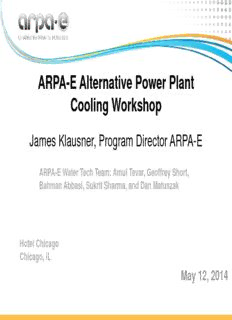
James Klausner, ARPA-E PDF
Preview James Klausner, ARPA-E
ARPA-E Alternative Power Plant Cooling Workshop James Klausner, Program Director ARPA-E ARPA-E Water Tech Team: Amul Tevar, Geoffrey Short, Bahman Abbasi, Sukrit Sharma, and Dan Matuszak Hotel Chicago Chicago, IL May 12, 2014 Presentation Topics I Framing the Problem II Programmatic Objectives III Transformative Technology Solutions IV Proposed Performance Targets 2 Framing the Problem Water as a Global Problem ●More than 1.1 billion people across the globe currently lack access to safe drinking water ●Fresh water supplies are declining while populations are increasing ●United Nations predicts that by 2027 one third of the world will face water scarcity problems ●70% of global fresh water demand is used for agriculture ●It is estimated that 15-35% of irrigation practices worldwide are unsustainable due to pumping ground water aquifers faster than they can recharge ●International Food Policy Research Institute predicts 120% increase in food prices by 2025 due to fresh water shortages 4 Energy/Water as a U.S. Problem ●41% of freshwater drawn in the U.S. is for thermoelectric power plant cooling ●3% of cooling tower water load is evaporated and dissipated ●Warming trend and over-pumping of natural water bodies places water cooling for thermoelectric power production at risk ●Desalination technologies in water stressed regions are energy intensive ●Water demand for fossil energy exploration and production is increasing ●Agricultural runoff water is damaging eco systems and is increasingly regulated 5 Majority of U.S. Fresh Water Withdrawal is for Cooling Thermoelectric Power Plants Withdrawal (2005, US) 197 billion m3 annual withdrawal for thermoelectric power 22 billion m3 withdrawn for cooling towers, 5 billion m3 dissipated 287 m3 water required per metric ton of potatoes produced 17.4 Mtons of potential food production dissipated (more than 5 times world annual yield of potatoes) 6 U.S. Power Plant Infrastructure is Heavily Reliant on Water Cooling 99% 1% <1% 7 Current Trends in Consumption, Population Growth, and Climate, Create Barriers for Power Plant Water Cooling ●Lack of water availability/drought/population growth – Regional problems (FL, TX, CA) ●Rising water temperature and effluent temperature limits – Curtailed production for existing plants – Permitting restrictions for new plants – EPA 316a – thermal discharge limits ●Other Regulations – EPA 316b putting more difficult requirements on once- through cooling systems 8 Lack of Water Availability/Drought 9 Drought Vulnerability Impacts Regional Food Production n o it a t ip ic Almond Farm , February 25, 2014 in e r p Turlock, California. f o s e h c n I n o it a t ip ic At ARPA-E: e r p 3 1 0 2 10
Description: